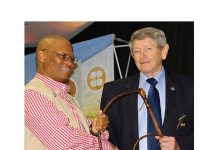‘If there is to be any future growth in the grain economy, we need to attend to: partnerships; what we focus on; what issues we prioritise; how we co-ordinate within the value chain and how we execute policy.’ This is the opinion of Dr Ferdi Meyer, managing director of the Bureau for Food and Agricultural Policy (BFAP), who spoke at the SA Grain Congress in March.
It’s not insignificant that Grain SA and BFAP have been collaborating to collect data and look for creative ways to carry strategic messages to policy-makers, business and decision-making forums. Dr Meyer presented Congress with statistics and data relating to a variety of issues within the agricultural sector.
Jobs, growth and the National Development Plan (NDP)
There are some areas like under-utilised land and smallholder farmers where there should be great potential job opportunities, but instead numbers have declined. Export-led sector jobs at farm level have increased and the agro-processing and integrated value chain has seen encouraging growth.
It is significant that commercial crop production and livestock production are not considered to be labour intensive, therefore they are not rated highly in terms of job creation. However, it is a significant feeder into the formal and informal value chains, including the agro-processing and export sectors, which are highly labour intensive.
The value of agriculture
Dr Meyer believes that ‘the real value of agriculture, especially in rural economies, is completely underestimated’. For example, citrus, macadamias, dairy and pork have all already surpassed the NDP production targets for 2030. He points out that the feed and livestock industries are performing very well. In the period from 2012 to 2018 South Africa has moved from being a net importer to a net exporter of beef.
The national pig herds tell a positive story as the estimated standing stock in the formal sector is valued at R2,44 billion, whereas in the informal (and unreported) sector, the estimated stock value is R1,24 billion.

Opportunity for growth
BFAP together with Grain SA are actively analysing scenarios to inform government of the pressures and high risks faced in the agricultural sector. According to Dr Meyer, there is opportunity for growth if the value chains in the informal sectors are built.
‘We are competing in a global environment which operates on high volumes and low margins and we have experienced long-term declining price trends for our produce. There have also been significant area shifts for summer crops driven by export market dynamics, domestic demand structures and relative profitability levels, e.g. more yellow maize than white maize is being grown and the feed market is dynamic and growing.’
General agricultural GDP performance reflects periods of growth driven by international factors like biofuel, China’s economy, droughts in the United States and low stocks. Domestic drivers include sustained investments and export-driven expansion. Weak performance periods are due to global recession, local weather patterns and the impact of disease such as foot and mouth disease.
Bending the curve going forward
Dr Meyer believes that going forward, the industry will need government support and protection. Policy and investment are required to drive inclusive agricultural transformation.
He believes that in order to motivate for improved support, the industry needs to get better at measuring what impacts there are. ‘We have a lot of potential to bend the curve and create a downstream value chain in the economy. The soybean industry for example has seen tremendous growth – 10% per annum for the last ten years. The chicken and poultry markets have the potential to reduce imports and make the local industry more competitive and create job opportunities.’ Dr Meyer further believes that South African producers have challenges in terms of cost of production and that they will have to make strategic changes. Many will have to integrate a bigger livestock component.
Maize value chain shifting to transformed state
In his presentation, Dr Meyer red-flagged issues affecting long-term sustainability. He said messages that will bend the curve need to be constructed. These messages include the following:
- Private sector interventions provide skills transfer, but we need direct subsidies for smallholders.
- Land reform policy and land expropriation need to be resolved and clarified for all.
- All producers need affordable crop insurance.
- Research and development must be prioritised and funded.
- Import-export movement relies on efficient ports, rails and harbours to open up markets.
- Infrastructure needs to be developed and maintained, such as electricity, water supply and roads.
- A new Poultry Master Plan has been signed and must be implemented effectively.
Ideas to take home
- Producers need an organisation that is gathering accurate data.
- This requires the Grain SA team to be constantly highlighting trends and assessing how we can maintain the productivity of our sector.
- The role of Grain SA and BFAP in gathering and sharing accurate data is critical.
- Messages must be communicated effectively to policy-makers to ensure informed policy-making towards a sustainable, vital agricultural sector.



















